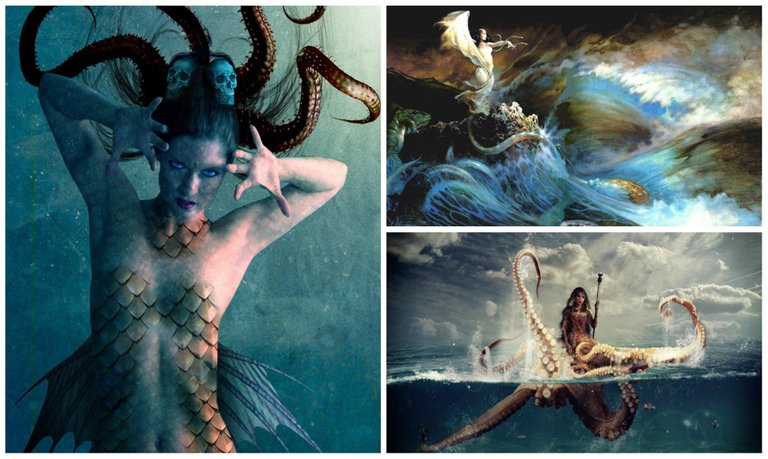
Multitud de libros, películas o leyendas que viajan mediante el boca a boca, han narrado historias de seres mitológicos del mar y sus aguas. Desde los cuentos de terribles monstruos del mar, que acababan con los buques y los marineros que sobre ellos navegaban, hasta las historias de sirenas, que con sus cánticos embelesaba a las tripulaciones con el fin de arrastrarlos a un terrible final, han sobrevivido al paso de los siglos.
Kraken
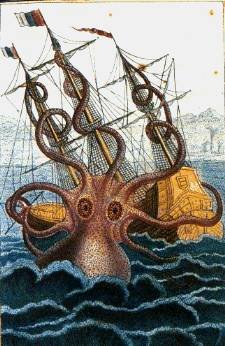
El Kraken es originario de la mitología escandinava y finlandesa. En los libros y leyendas era descrito como un pulpo gigante que emergía de las aguas de grandes profundidades para enfrentarse a marineros y atacar sus embarcaciones.
Las antiguas narraciones y libros de cuentos, describían al Kraken como un cefalópodo “del tamaño de una isla flotante” (se decía que el dorso del pulpo tenía una extensión de,aproximadamente,2,4 kilómetros). El peligro real de este monstruo no eran sus ataques a los barcos, si no el potente remolino que originaba tras sumergirse de nuevo en el océano. Sin embargo, su potencial destructivo también era temido por todas las tripulaciones; contaba la leyenda que era capaz de aferrar al mayor buque de guerra y arrastrarlo hasta el fondo de los mares más profundos.
Actualmente, con el descubrimiento del calamar gigante, los historiadores se preguntan si la leyenda pudo haberse originado por avistamientos de calamares gigantes reales que podrían tener entre 13 y 15 metros de longitud, incluyendo los tentáculos.
Leviatán
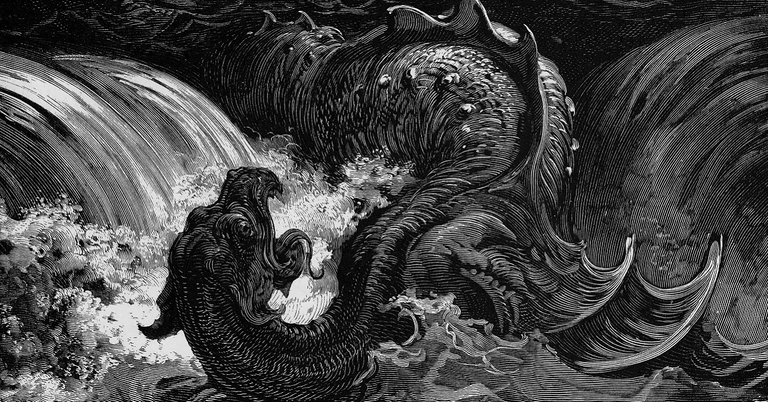
Leviatán es un término que en infinidad de ocasiones se ha utilizado para describir a grandes bestias o a monstruos despiadados. Sin embargo,su más reconocida figura tiene origen en el Antiguo Testamento,a menudo asociada con Satanás.
Durante la época dorada de los viejos marineros europeos,Leviatán era considerado una ballena de enormes dimensiones que devoraba buques de grandes dimensiones. También fue considerada una serpiente de una longitud indeterminada que nadaba velozmente haciendo círculos con los que crear peligrosos remolinos de los que los buques no podían escapar.
Se han buscado paralelismos entre Leviatán y otras figuras y leyendas del mar,tales como la Naga de siete cabezas.
Sirenas
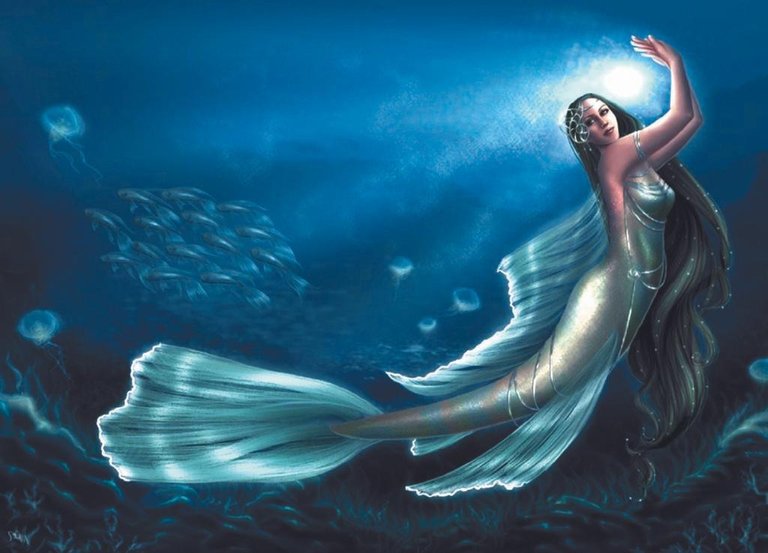
Las sirenas son seres mitológicos cuya función y representación ha variado con el paso de los años. En los orígenes, las sirenas eran consideradas genios marinos híbridos de mujer y ave, pero desde hace bastante tiempo, la representación más común las describe como bellas mujeres que tienen cola de vez en lugar de piernas.
Según la mitología griega, la imagen de la sirena estaba asociada al mundo de los muertos y eran vistas como las encargadas de transportar las almas al Hades; en las Islas Británicas, las sirenas eran consideradas presagios de mala suerte; en China, las sirenas eran consideradas lágrimas que se transformaban en piedras preciosas, etc. Sin embargo, por lo que son más conocidas las sirenas son por la leyenda de Jasón y los Argonautas.
La leyenda cuenta que los marineros, encandilados por la voz de las sirenas, pusieron rumbo al lugar donde ellas habitaban y se dejaron engañar. Orfeo, gracias a su habilidad, consiguió acallar los cantos de las mismas con música, de manera que los cantos no se pudiesen escuchar. Derrotadas por Orfeo, las sirenas se transformaron en piedra.
Moby Dick
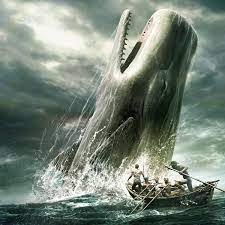
La ballena Moby Dick fue la protagonista de la novela publicada por el escritor estadounidense Herman Melville; libro que relata las aventuras del buque ballenero Pequod en su persecución de la ballena blanca; el terrorífico monstruo marino.
El barco dirigido por el misterioso capitán Ahab, zarparía con un objetivo primordial, que no se centraría en la caza de ballenas en general, si no en la caza de Moby Dick. Este monstruo marino le había arrebatado su pierna, tal y como contaría antes de zarpar a su tripulación.
Moby Dick fue conocido como el monstruo asesino que causó estragos a todos y cada uno de los balleneros que habían intentado darle caza.
Monstruo del Lago Ness
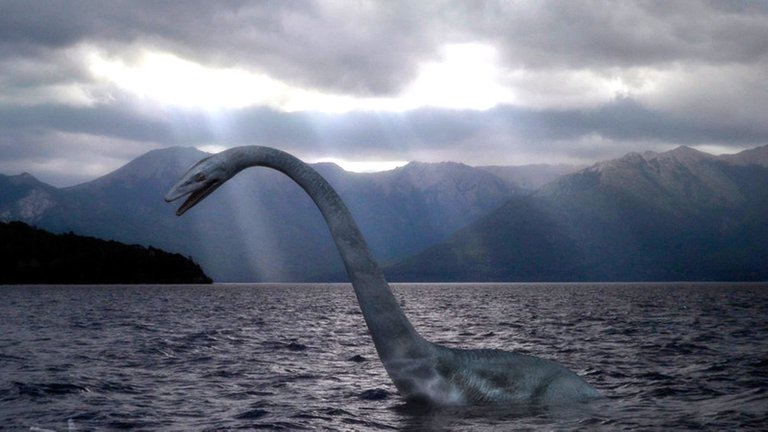
El monstruo del lago Ness, más conocido como Nessie, es una criatura marina de grandes dimensiones que se dice lleva habitando en las aguas del lago Ness desde tiempos inmemorables.
La mayoría de los estudios realizados no son convincentes y no se ha podido demostrar nunca la verdadera existencia de este lagarto, sumergido en las aguas dulces de Escocia desde hace más de 1.500 años.
Hay rumores de que muchos locales han visto a la criatura y de que argumentan a favor de su existencia. De ser así, la mayoría de las descripciones sobre el aspecto del monstruo indican que sería similar o muy parecido a los antiguos y ya extintos plesiosaurios.
La única prueba que existía de su veracidad y existencia, fue la afamada fotografía obtenida por M. Wetherell. Sin embargo, fue confirmada como un engaño cuando Chris Spurling, yerno de M. Wetherell, yacía en su lecho de muerte.
Jörmundgander o la Serpiente de Midgard
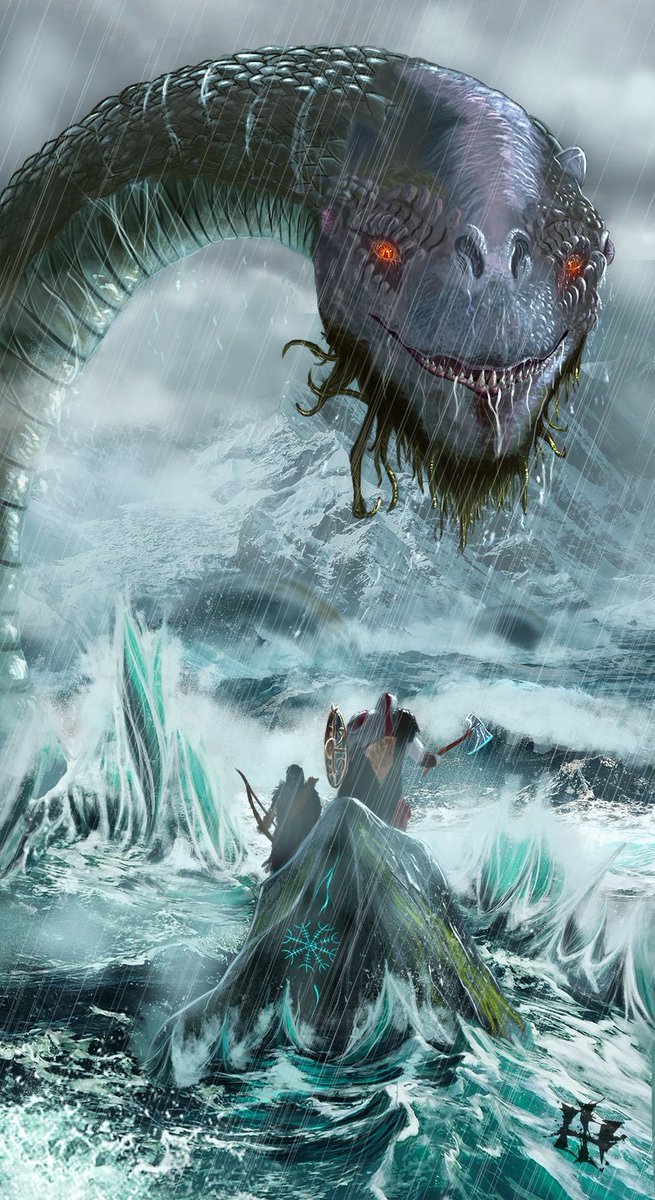
Jörmundgander se trata de una serpiente gigantesca que tiene al dios Loki como padre y a la mujer gigante Angrboda. Tenía como enemigo al dios Thor y fue lanzada al mar por Odín,que quería deshacerse de semejante aberración.
Este monstruo creció y se desarrolló hasta el Ragnarök,día de la destrucción total,momento en el cual Jörmundgander era tan grande que se dice podía abrazar a la tierra con toda su extensión.
Hay tres mitos destacados acerca de dicho ser mitológico,siendo el tercero de ellos el más conocido. Este último narra como Thor y Jörmundgander se encuentran con la llegada del Ragnarök. La serpiente se arrastra fuera del agua y envenena los cielos,intentando reptar hacia Thor. Thor lucha contra ella y le dará muerte aunque finalmente,y tras caminar nueve pasos,el dios caerá muerto también a causa del veneno de la serpiente.
Makara

Es una criatura marina de la mitología hindú. En general se representa como una criatura medio terrestre, medio marina. La parte superior de su torso suele presentar la constitución de un animal terrestre, tal como un elefante, ciervo o venado. La parte inferior, presenta una cola de animal acuático.
Makara es el vehículo de la diosa del río Ganges y del dios del mar Varuna. También es el símbolo del signo astrológico de Capricornio, uno de los doce símbolos del zodiaco.
Hipocampo
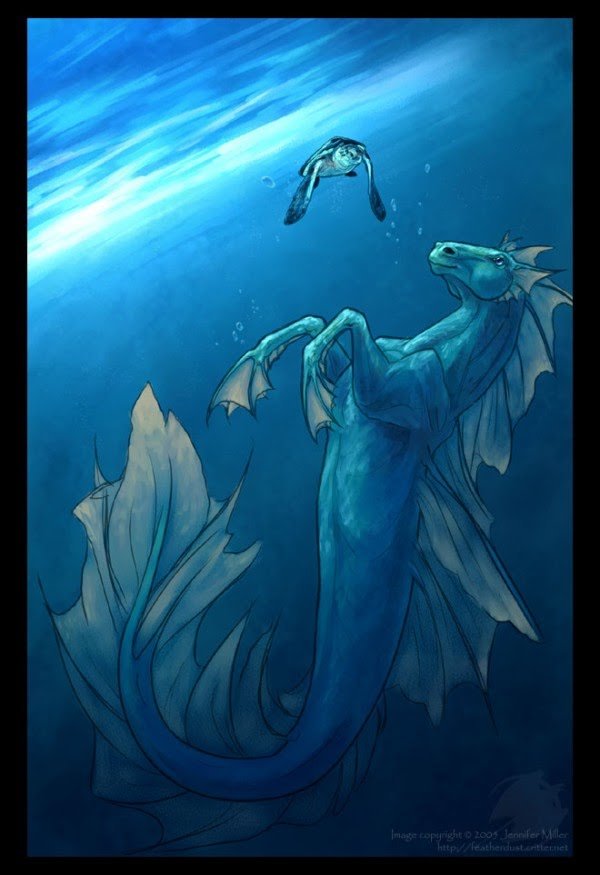
En la mitología griega se trababa de un caballo marino que desde la parte inferior del cuerpo tenía forma de cola de pez. Vivía tanto en aguas dulces como saladas y podía respirar aire. Eran herbívoros y se alimentaban de algas.
Este ser aparece en poemas homéricos como símbolo de Poseidón,cuya carroza era tirada sobre la superficie de los océanos por veloces y hermosos corceles. Estaban considerados los salvavidas del mar,pues recataban a cualquier persona (principalmente pescadores) que caía al agua.
Homero es uno de los primeros en describir a este ser en la Ilíada. Apolonio de Rodas también lo describió en su poema épico Argonáuticas. Otros autores griegos que hacen referencia a este ser son: Virgilio en Geórgidas; Eurípides en Andrómeda y Estacio en Tebaida. Actualmente conocemos muchos más datos sobre el «caballito de mar».
Umibōzu

Umibōzu es un espíritu del folklore japonés que vive en el fondo del mar y hace zozobrar a cualquier buque cuyo capitán o tripulación se atreva a hablar con él. Según la historia,cuando Umibōzu enfurecía les pedía a los tripulantes un barril de madera. La criatura llenaba dicho barril con agua de mar para ahogar a los navegantes,de manera que no podían escapar. Para evitar el final destino,la única solución era darle un barril sin fondo.
Esta leyenda está relacionada con una tradición japonesa que dice que las almas de las personas que no tienen a nadie para cuidar sus tumbas,se refugiarán en el mar.
El nombre que se le da a esta criatura combina el carácter de mar con el carácter de monje budista.
Hidra de Lerna
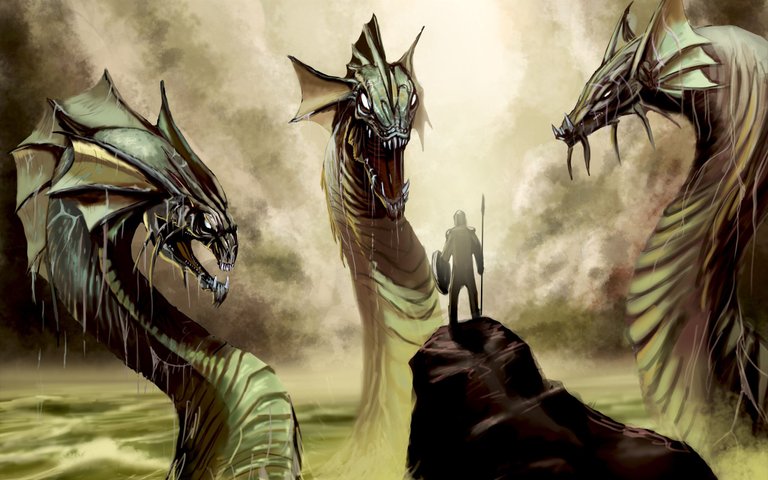
Se trata de un monstruo acuático de la mitología griega con forma de serpiente de varias cabezas y aliento venenoso,hija de Tifón y la Equidna. Tenía la virtud de regenerar dos cabezas por cada una que perdía o le era amputada. Habitaba en el lago de Lerna en el golfo de Argólida.
Se decía que era hermana del León de Nemea y que por ello buscaba venganza por la muerte de éste a manos de Heracles (Hércules). Heracles acabó con ella en el segundo de sus doce trabajos.
Créditos por las imágenes a: https://sectormaritimo.es/diez-asombrosas-criaturas-mitologicas-del-mar-y-sus-aguas ,https://supercurioso.com/conoce-a-las-brujas-de-agua-aterradoras-y-maravillosas/, https://es.wikipedia.org/wiki/Kraken, https://www.muyhistoria.es/h-antigua/articulo/leviatan-el-monstruo-de-la-biblia-741650017071,https://es.scribd.com/article/554498848/Sirenas-Criaturas-Legendarias-Mitologicas, https://reinoanimalia.fandom.com/es/wiki/Moby_Dick, https://demonstruos.net/2021/03/22/resuelto-el-misterio-del-monstruo-del-lago-ness/, ~~~ embed:1101607128031248388?lang=el, https://www.deviantart.com/vincent-covielloart/art/Makara-750093058, https://sites.google.com/site/fantasiaymitologia/hipocampo, https://es.wikipedia.org/wiki/Umib%C5%8Dzu, https://www.pinterest.es/pin/361343570078547338/ twitter metadata:YWxla2F5eHx8aHR0cHM6Ly90d2l0dGVyLmNvbS9hbGVrYXl4L3N0YXR1cy8xMTAxNjA3MTI4MDMxMjQ4Mzg4fA== ~~~
English

Many books, films or legends that travel by word of mouth, have told stories of mythological beings of the sea and its waters. From tales of terrible monsters of the sea, which killed the ships and sailors who sailed on them, to the stories of mermaids, who with their songs enraptured the crews in order to drag them to a terrible end, have survived the passing of the centuries.
Kraken

The Kraken originates from Scandinavian and Finnish mythology. In books and legends it was described as a giant octopus that emerged from the waters of great depths to confront sailors and attack their vessels.
Ancient tales and storybooks described the Kraken as a cephalopod "the size of a floating island" (the back of the octopus was said to have an extension of approximately 2.4 kilometers). The real danger of this monster was not its attacks on ships, but the powerful whirlpool it created after diving back into the ocean. However, its destructive potential was also feared by all crews; legend had it that it was capable of grabbing the largest warship and dragging it to the bottom of the deepest seas.
Today, with the discovery of the giant squid, historians wonder if the legend may have originated from sightings of real giant squid that could be 13 to 15 meters long, including tentacles.
Leviatan

Leviathan is a term that has been used on countless occasions to describe great beasts or ruthless monsters. However, its most recognized figure originates from the Old Testament, often associated with Satan.
During the golden age of the old European sailors,Leviathan was considered a whale of enormous dimensions that devoured large ships. It was also considered a serpent of indeterminate length that swam swiftly in circles to create dangerous whirlpools from which ships could not escape.
Parallels have been sought between Leviathan and other figures and legends of the sea, such as the seven-headed Naga.
Sirens

Mermaids are mythological beings whose function and representation has varied over the years. Originally, mermaids were considered marine genies, hybrids of woman and bird, but for quite some time, the most common representation describes them as beautiful women who have tails instead of legs.
According to Greek mythology, the image of the mermaid was associated with the world of the dead and they were seen as the ones in charge of transporting souls to Hades; in the British Isles, mermaids were considered omens of bad luck; in China, mermaids were considered tears that transformed into precious stones, etc. However, what mermaids are best known for is the legend of Jason and the Argonauts.
The legend tells that the sailors, dazzled by the voice of the sirens, set course for the place where they lived and allowed themselves to be deceived. Orpheus, thanks to his skill, managed to silence the songs of the sirens with music, so that the songs could not be heard. Defeated by Orpheus, the sirens were transformed into stone.
Moby Dick

The whale Moby Dick was the protagonist of the novel published by the American writer Herman Melville; a book that recounts the adventures of the whaling ship Pequod in its pursuit of the white whale; the terrifying sea monster.
The ship led by the mysterious Captain Ahab, would set sail with a primary objective, which would not focus on whaling in general, but on the hunt for Moby Dick. This sea monster had taken his leg, as he would tell his crew before setting sail.
Moby Dick was known as the killer monster that wreaked havoc on each and every whaler that had tried to hunt him down.
Loch Ness Monster
 )
)
The Loch Ness Monster, better known as Nessie, is a large sea creature said to have inhabited the waters of Loch Ness since time immemorial.
Most studies have been unconvincing and have never been able to prove the true existence of this lizard, which has been submerged in the fresh waters of Scotland for more than 1,500 years.
There are rumors that many locals have seen the creature and argue for its existence. If so, most descriptions of the monster's appearance indicate that it would be similar or very similar to the ancient and now extinct plesiosaurs.
The only proof that existed of its veracity and existence was the famed photograph obtained by M. Wetherell. However, it was confirmed as a hoax when Chris Spurling, son-in-law of M. Wetherell, lay on his deathbed.
Jörmundgander or the Midgard Serpent

Jörmundgander is a gigantic snake that has the god Loki as its father and the giant woman Angrboda. His enemy was the god Thor and was thrown into the sea by Odin, who wanted to get rid of such an aberration.
This monster grew and developed until Ragnarök, the day of total destruction, at which time Jörmundgander was so large that it is said he could embrace the earth with its entire length.
There are three prominent myths about this mythological being, the third being the best known. The latter tells how Thor and Jörmundgander meet with the coming of Ragnarök. The serpent crawls out of the water and poisons the skies,trying to crawl towards Thor. Thor fights against it and kills it, but finally, after walking nine steps, the god will also fall dead because of the snake's venom.
Makara

It is a sea creature from Hindu mythology. It is generally depicted as a half-terrestrial, half-marine creature. The upper part of its torso usually presents the constitution of a terrestrial animal, such as an elephant, deer or deer. The lower part, presents a tail of an aquatic animal.
Makara is the vehicle of the goddess of the river Ganges and the sea god Varuna. It is also the symbol of the astrological sign of Capricorn, one of the twelve symbols of the zodiac.
Hippocampus

In Greek mythology it was a sea horse that had a fish tail shape from the lower part of its body. It lived in both fresh and salt waters and could breathe air. They were herbivorous and fed on algae.
This being appears in Homeric poems as a symbol of Poseidon, whose chariot was pulled over the surface of the oceans by swift and beautiful steeds. They were considered the lifeguards of the sea, as they rescued anyone (mainly fishermen) who fell into the water.
Homer is one of the first to describe this being in the Iliad. Apollonius of Rhodes also described it in his epic poem Argonautica. Other Greek authors who refer to this being are: Virgil in Georgidas; Euripides in Andromeda and Statius in Thebaida. Nowadays we know much more about the "seahorse".
Umibōzu

Umibōzu is a spirit of Japanese folklore who lives at the bottom of the sea and capsizes any ship whose captain or crew dares to speak to him. According to the story, when Umibōzu was enraged, he would ask the crew for a wooden barrel. The creature would fill the barrel with seawater to drown the sailors so that they could not escape. To avoid their final fate, the only solution was to give them a bottomless barrel.
This legend is related to a Japanese tradition that says that the souls of people who have no one to guard their graves will take refuge in the sea.
The name given to this creature combines the character of the sea with the character of a Buddhist monk.
Hydra of Lerna

It is an aquatic monster of Greek mythology in the form of a multi-headed serpent with poisonous breath, daughter of Typhon and Echidna. It had the virtue of regenerating two heads for each one that was lost or amputated. She lived in the lake of Lerna in the gulf of Argolid.
It was said that she was the sister of the Lion of Nemea and therefore sought revenge for his death at the hands of Heracles (Hercules). Heracles killed her in the second of his twelve labors.
Image credits to: : https://sectormaritimo.es/diez-asombrosas-criaturas-mitologicas-del-mar-y-sus-aguas ,https://supercurioso.com/conoce-a-las-brujas-de-agua-aterradoras-y-maravillosas/, https://es.wikipedia.org/wiki/Kraken, https://www.muyhistoria.es/h-antigua/articulo/leviatan-el-monstruo-de-la-biblia-741650017071,https://es.scribd.com/article/554498848/Sirenas-Criaturas-Legendarias-Mitologicas, https://reinoanimalia.fandom.com/es/wiki/Moby_Dick, https://demonstruos.net/2021/03/22/resuelto-el-misterio-del-monstruo-del-lago-ness/, ~~~ embed:1101607128031248388?lang=el, https://www.deviantart.com/vincent-covielloart/art/Makara-750093058, https://sites.google.com/site/fantasiaymitologia/hipocampo, https://es.wikipedia.org/wiki/Umib%C5%8Dzu, https://www.pinterest.es/pin/361343570078547338/ twitter metadata:YWxla2F5eHx8aHR0cHM6Ly90d2l0dGVyLmNvbS9hbGVrYXl4L3N0YXR1cy8xMTAxNjA3MTI4MDMxMjQ4Mzg4fA== ~~~
Copying/Pasting content (full or partial texts, video links, art, etc.) with adding very little original content is frowned upon by the community. Publishing such content could be considered exploitation of the "Hive Reward Pool" and may result in the account being Blacklisted.
Please refrain from copying and pasting, or decline the rewards on those posts going forward.
If you believe this comment is in error, please contact us in #appeals in Discord.